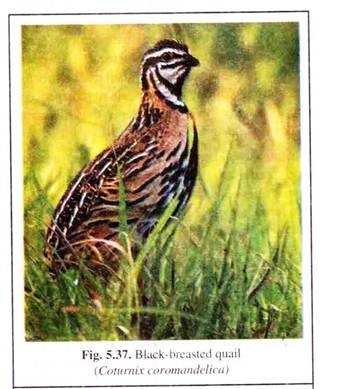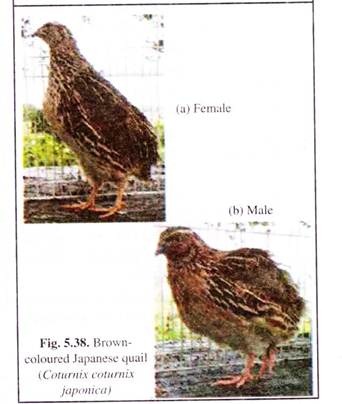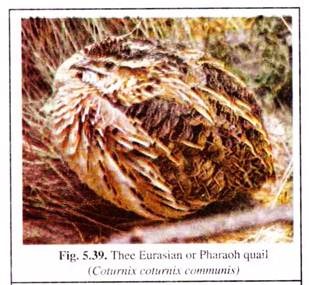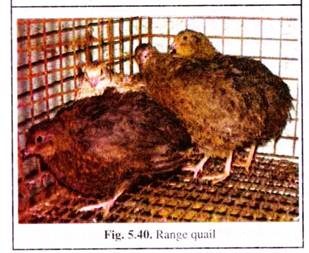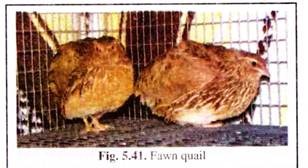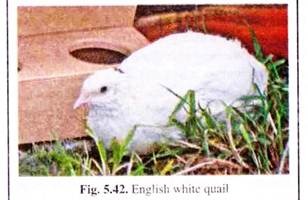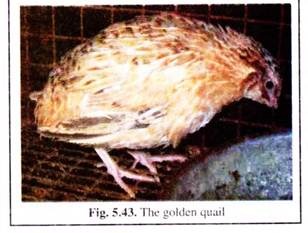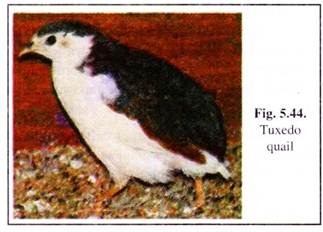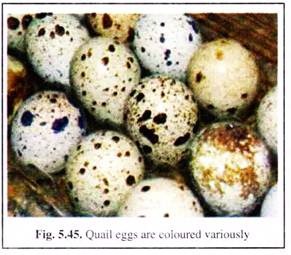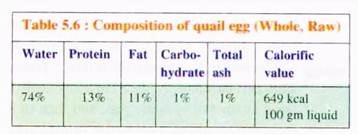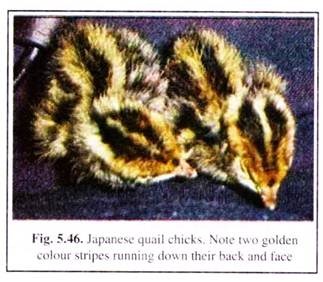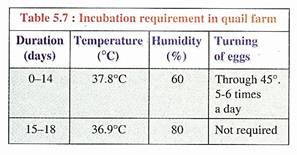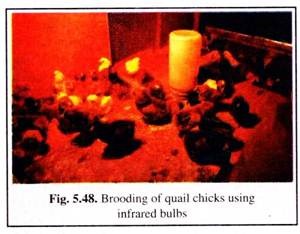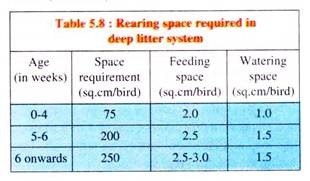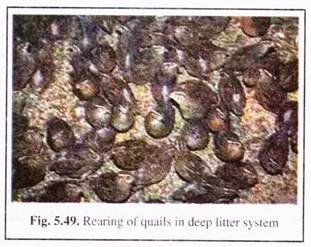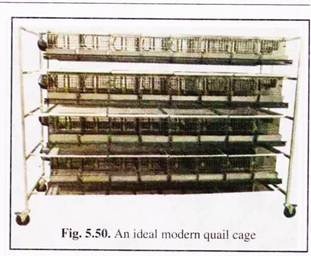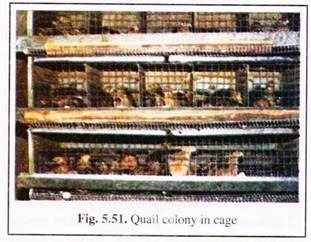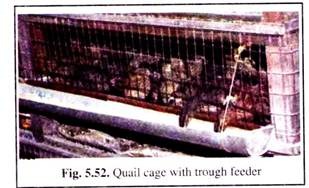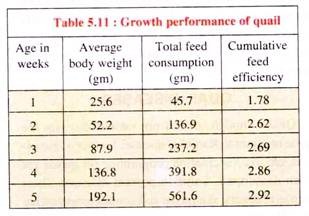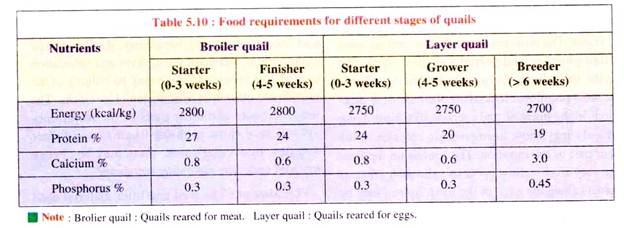In this article we will discuss about Quails:- 1. Meaning of Quail 2. Distribution of Quails 3. Brief History 4. Taxonomy 5. Popular Breeds 6. Life History 7. Rearing 8. Diseases 9. General Health Care 10. Economics.
Meaning of Quail:
The Quail, also called “bater” in Hindi, is a small type of bird known as backyard chicken. The bird originated from a wild environment just as any other domesticated animal and was first domesticated in Japan in 1595. There are 45 species of quail worldwide.
However, only two species of quail are popular in India; the black-breasted jungle or rain quail (Coturnix coromandelica) (Fig. 5.37) found in jungle and the brown-coloured Japanese quail (Coturnix coturnix japonica) (Fig. 5. 38) which is bred for meat or used for commercial purposes.
While Indian jungle quail weighs up to 100 gm and lays about 100 eggs a year, the Japanese quail weighs up to 250 gm and lays about 250 eggs a year. Although the Japanese quail is the largest species, it is much smaller than pigeon.
ADVERTISEMENTS:
Because of prolific egg production and meat yield, it attained the status of viable commercial poultry enterprise. It is very ideal for creation of rural employment, solving the gender issue in employment and also provides supplemental income and protein requirement to rural farmers.
Distribution of Quails:
The Japanese quail is found in East Asia. Being migratory in nature, the wild Japanese quail is available in Manchuria, south-eastern Siberia, northern Japan, and the Korean Peninsula. It is also found in some parts of the north eastern regions of India like Sikkim, Bihar and parts of Assam. They dwell in grasslands and cultivated fields.
Brief History of Quails:
ADVERTISEMENTS:
The reference to quails can be traced back in the old testament of Bible. Egyptians were known to catch quail for meat. In China, these birds were raised as pets as singing birds. In late eleventh century, quail was brought to Japan from China.
It is known that a Japanese Emperor got cured from tuberculosis after eating quail meat. Afterwards, Japanese people started raising quail extensively for meat and egg. Since the wild quails were tamed and bred in captivity by Japanese people, the birds came to known as Japanese quail.
In India, quail keeping started in 1974 at Ijatnagar, when Central Avian Research Institute, introduced improved germ plasm of domesticated quail varieties from Japan, and then in 1983 at Tamil Nadu. Thereafter, agricultural Universities of Andhra Pradesh, West Bengal; veterinary colleges as well as animal husbandry department played a vital role in the promotion of quail breeding as a farm enterprise.
Taxonomy of Quails:
Quail is a collective name for several genera of mid-sized birds generally belongs to the order Galliformes. Old World quails are found in the family Phasianidae that includes mainly Coturnix Quail, the Chinese Blue Breasted “Button” quail and the African Harlequin Quail.
ADVERTISEMENTS:
The New World quails belong to the family Odontophoridae and include Marbled Wood Quail, Bobwhite, Spot- winged Wood Quail, Black-earnbed Wood Quail, Rufous-fronted Wood Quail, Black-fronted Wood Quail, etc.
In recent years, Japanese quail, Coturnix coturnix japonica, is the most productive commercial strain in India. But there is a great deal of confusion about the origin of the Coturnix quail as we know them today.
No one can know how the various breeds and subspecies developed, but it is generally acknowledged that all the Coturnix types are originally based on the common quail, Coturnix coturnix, the wild migratory bird of Europe, Asia and Africa.
Various sub-species then developed from this, including the European quail, Coturnix coturnix coturnix; the Eurasian quail, Coturnix coturnix communis, and the Japanese quail, Coturnix coturnix japonica.
Systematic Position of Quail Found in India
Kingdom: Animalia
Phylum: Chordata
Class: Aves
Order: Galliformes
ADVERTISEMENTS:
Family: Phasianidae
Genus: Coturnix
Some Popular Breeds of Quail:
There are many breeds of Coturnix quail are available. According to colour varieties some popular breeds are mentioned here.
(1) The Eurasian or Pharaoh Quail (Coturnix Coturnix Communis):
It is a wild type quail breed, having a mix of feather colour with black and various shades, brown colour being predominant. In male, the face and throat is rusty brown and the upper breast is cinnamon in colour. In female, the face, throat and upper breast are light cinnamon with black, while the lower breast is tan in colour (Fig. 5.39). This breed is a good layer.
(2) Range Quail:
The overall colouring is dark brown, so that some people refer to them as Brown quail. The markings of the range are essentially a lighter brown body colour overlaid with darker- brown, along with a certain amount of dark grey feathering on the back and as a faint patch on the throat (Fig. 5.40). All range quails are good layers.
(3) Fawn Quail:
Essentially like all other Coturnix breeds, the overall impression of the fawn is a lovely warm pinkish-brown. The fawn feathers are pencilled with white and the white eyebrow lines are present. Beak and legs are light pinkish-brown and eyes are dark brown (Fig. 5.41).
(4) White Quail:
Sometimes called English White; good specimens are completely white, with no discernible markings, other than on the head. Beak and legs are pinkish brown and eyes are dark brown (Fig. 5.42). English white quail is a layer but American white breeds are good broiler.
(5) Golden Quail:
These quails are golden to white straw coloured. The male is lighter while the female is darker and more striated. She also has distinctive brown stripes around the face. In the USA, golden strains known as Manchurian Gold. In Britain and Europe, Italian or Golden Italian is the name given to the golden variety (Fig. 5.43).
(6) Tuxedo Quail:
This is an apt name for a bird with a smart white waistcoat to contrast with its dark brown overcoat. The two-colour pied pattern is the result of a crossing between the dominant dark brown and recessive white genes.
The colour of back feathers is identical with those of the Range, while the white plumage is like that of the English White. The markings are often variable. The ideal ones are clear while face, chest and belly, with dark brown back, tail and crown (Fig. 5.44).
Life History of Japanese Quail:
Adults:
The male Japanese quail has an even coloured rusty breast feathers with only few speckles of white. The adult females have grey and black speckled breast feathers (Figs. 5.38 a & b). The males possess a cloacal gland that secretes a white foamy material. Male quails usually make a different sound which is usually disturbing to the human. Sex differences in plumage colour appear about 3 weeks of age.
The body weight of adult male quail is about 140 gm, while the females are slightly heavier, weighing 150 to 180 gm. Growth rate is three times faster than domestic fowl. They attain very early sexual maturity. By about 50 days of age, the females become capable of full egg production.
Rate of egg production in domesticated quail is controlled by the availability of light. Balanced diet is another factor which influences the rate of egg production. Animal protein in the diet improves egg production better than vegetable protein, as the latter lack essential amino acids like methionine and lysine.
Mating and Fertility:
In animal, inbreeding reduces the rate of egg production in the females and poor semen production in males. The rate of egg production is reduced with the advance in age of the bird. Hence, the young stock should be preferred.
The optimum period for good egg production is 10-30 weeks of age. Fifty per cent level of egg production is generally achieved at the age of 7-8 weeks, while over 80% is attained after 10 weeks of age. To obtain fertile hatching eggs from quail, equal number of males and females are not required.
Laying and Hatching:
The female lays eggs every 16-24 hours for 8-12 months during first year. Second year egg production is 48% of the first year’s production and falls drastically in subsequent years. Quail eggs are multi-coloured and heavily mottled with black, brown and blue (Fig. 5.45).
Weight of egg is 6.7-13.8 gm. Quails require about 16-18 hours light for optimum production of eggs. The proportion of yolk (the yellow inside part) to albumen (the white part) is 39:61 and is higher compared to chicken eggs. The composition of quail eggs is given in Table 5.6).
For natural incubation of eggs quails, mini hens, doves, pigeons, etc. can be utilised. First, unfertilised eggs are given to the birds for 2-3 days to check their acceptability. Thereafter, 2-10 fertilised eggs are given for incubation.
Broody birds are provided with straw for nest, light, food, water, etc. Artificial incubation is a more controlled process. Incubation period for quail eggs is 18 days. After that the young chicks are hatched out.
Japanese quail chicks are dark brown in colour with two golden stripes running down their back and face, looking like pheasant chicks (Fig. 5.46). Newly hatched chicks require desirable temperature of about 35°C during the first week of brooding, which is gradually reduced at the rate of 3.5°C per day until it reaches 21°C.
Floor, feeder and water space should be increased with advancement in age. At the age of four weeks, chicks are fully feathered. Feather picking or other forms of cannibalism may occur when Japanese quails are kept in wire-cage. Beak trimming may be necessary as early as two weeks of age and may be done by using nail-cutters. Young birds can be transferred from brooder to cages or floor around the fourth week.
Rearing of Quails in Farm:
For commercial purposes, quails are reared in farm (quailery) with various systems. Here, some general systems are being described.
(1) Breeding:
Two main methods of breeding are normally practised in quail farms.
(a) In one method, seven quails are kept in a cage/ housing with the male-female ratio of 2: 5. It is time saving and can be adopted for large scale breeding but has some disadvantages as well, like frequent fights between the males, which causes general nervousness in the cage and the fertilisation and egg laying rate can become irregular.
(b) In the other method, individual males and females are kept separately and the males/ females are placed into the cages periodically for mating. It’s a good practice on a small scale with high fertility rate where desired colours and patterns of the quails can be produced. The only disadvantage of this method is that it is time consuming.
(2) Egg Laying:
Under ideal conditions, females produce about 250 to 300 eggs per year. In farms, females usually lay 75% eggs between 3 to 6 p.m. and 20% of the eggs in total darkness. Quails require about 16-18 hours light for optimum egg production.
(3) Incubation:
The domesticated quail has lost the instinct of nesting. So for breeding purposes in quail farms, the eggs are hatched either with the help of incubator or by placing the eggs under a broody hen (ideally Bantam). Healthy eggs with strong shell are collected, checked and then placed on wire mesh or grid of 1.5 x 1 inch, fitted on the setter trays, to keep very small number of quail eggs in the incubator.
It is then adjusted with a temperature of 37.8°C and humidity level of 55-60%. If the incubator is not equipped with an automatic egg turning system, the eggs should be turned manually 5-6 times a day. Egg turning is very important to keep the little chick embryos in the middle of the egg and prevent them from sticking to the inside of the shell.
On the 15th day, turning the eggs should be stopped and the temperature is slightly lowered to 36.9°C. At this stage, humidity level is raised to above 80% which will soften the shell and help the little quail chicks to break out easily.
Then quail eggs are put on the hatching tray. Japanese quail chicks usually begin to hatch by the 16th day of incubation, but most of them should hatch on the 17th day. Any quail chicks that hatch after the 18th day will probably die. Hatching rate of 75% or above, indicates a good success. Incubation requirements in quail farm are as follows (Table 5.7).
Precautions to be taken for incubation:
Successful quail farming depends on proper incubation and hatching.
So following precautions are to be taken prior/during the process of incubation:
(1) Prior to incubation, eggs should be stored in a dry, cool place on egg trays with the broad end up. The storing temperature should be between 12-17°C and the relative humidity around 70-80 %. Eggs should never be stored in fridge.
(2) Washing the quail eggs is not allowed which can remove their porous protective coating and making them vulnerable to bacterial infections.
(3) For hatching, quail eggs should not be older than 7 days.
(4) It is also advisable to perform candling check of the eggs for the presence of any possible cracks, health of the yolks and the size of the airspace.
(5) Before incubation, eggs can be fumigated with a mixture of potassium permanganate and formalin. To prepare the mixture, potassium permanganate is placed in a low walled, large enamel or ceramic pan, and then to it formalin is added. Following fumigation, eggs are kept in a tray or dish which is then placed in the incubator with a temperature between 20-30°C and relative humidity of 80-90%.
(6) The room where the incubator is set up should be at constant temperature.
(7) The correct temperature level is very important. Under-incubating (temperature too low) will result in late hatching and over-incubating (temperature too high) will result in early hatching. Both cause death of quail chicks.
(8) The quail chicks will be allowed to come out from the shell on their own. No external forces should be put on the eggs during hatching.
(9) The chicks should be kept in the incubator until they become dry and fluffy. They are then placed into the pre-heated brooder. Sufficient time should be given before placing them, or else they will catch a cold, get curled up feet and die.
(10) The quail chicks should be left in the incubator for 24-48 hours after hatching.
(4) Brooding:
Brooding is a technique to keep the quail chicks in a safe and controlled environment with proper air, space, heat, water, and food in order to make them healthy as they can be, until they feather out. In quails, the brooding period extends between 0-3 weeks. However, in winter it can extend up to the 4th week. The average mortality is 6-10% during brooding period. So quail chicks need some tender care throughout the first week of life.
The Brooder:
Brooder is the place where quail chicks are kept just after hatching with special care (Fig. 5.47). It is of suitable size depending upon the number of quail chicks that will be kept into it. The chicks should have enough space to walk away from the heater lamp, if they want to cool down a bit.
The brooder is built before the hatching time and placed in a draught-free area. A bedding of about 2 to 4 inches, usually made of fine wood shavings, is put on the floor. For the first week, it is kept covered with paper or even better, with some textile, like an old heavy curtain or a bed sheet.
It is important to tack the sides as well, making it tight and secure to prevent the quail chicks from getting stuck in the gap or even in worse circumstances, to get under the cover. In the brooder the heating lamp is placed about 12 inches high from the chicks for fire safety reasons.
The heat level should be 35-36°C for the first week, followed by a decrease of 3.5°C for a week until the chicks are ready to move to their permanent place. The brooding of chicks can be done using infrared bulbs or gas brooders (Fig. 5.48).
Reducing of heat will depend on what type of a heater is used. In case of a heat lamp there are generally two ways. One is to keep lifting the heat lamp by a bit each time. The other is to start with a 250 W bulb, then change it to a 100 W bulb, then to a 60 W bulb. Thus, the chicks will gradually be used to day and night conditions.
Precautions to be taken in Brooder:
(a) Prior hatching, the heater lamp should be kept on in the brooder to make sure that the bedding -and the walls are sufficiently warm for them.
(b) Drinking area should not be too deep to prevent young quail chicks from drowning (They can drown in ¾ inch or less deep water).
(c) The quail chicks increase their size significantly by the time they reach 3-4 weeks of age and get fully feathered. The size of brooder should be made accordingly.
(d) Predators should be prevented from getting to the chicks.
(e) Quail chicks should have constant access to feed and cold water.
(f) Constant and strong light can cause aggressive behaviour in the chicks. So the light should be adjusted properly.
(g) After the first week, the bedding cover and the protection from drowning should be removed after proper checking.
(5) Rearing of Adult Birds:
Quails can be reared in both deep litter system and cage (battery) system.
Deep Litter System:
Space requirement for different purposes in deep litter system is mentioned below (Table 5.8).
Bedding:
Litter materials, like rice husk, sawdusts, crushed groundnut shells, wood shavings, ground corn, cobs, etc. are used in combination as bedding materials. The litter should be of organic origin but non-proteinaceous in nature. It should be hygroscopic, dry, free from pathogenic bacteria, moulds or fungi and should be locally available at cheap rate.
A five centimetre thick layer of suitable litter material may be spread on a clean floor at the beginning (Fig. 5.49). Gradually this thickness may be increased to 10 cm by 4-5 weeks.
Faeces and evaporation from the body and drinkers add moisture to the litter. The moisture content of the litter material should be between 25-30% and the excess amount of moisture should be removed.
Frequent stirring of the material and proper ventilation, generally help to maintain the litter in healthy condition. To ensure the healthy condition of the birds, the freshly spread litter material should be sprayed with any disinfectant, about 96 hours before the birds are expected to use it.
When humidity is high in the atmosphere, it may be necessary to add slaked lime (4-5 kg/10 square metres of floor area) to the litter. The wet patches around the waterers should also be replaced with fresh material.
During very dry conditions some moisture may be added to the litter material by fine spraying of water, to continue its proper conditioning and maturation process. A quail of 1 to 6 weeks of age may add about 360 gm of manure to the litter during the rest period of its life.
Cage (Battery) System:
Quails can be reared in cages of various types. Modern quail cage possess built-in systems for manure removal, feeding, drinking and egg collection (Fig. 5.50). Typically vertical battery cages with 4-6 tiers are used to save space and in each row, there may be more than one cage. Cages are made up of weld mesh of galvanised wire.
The bottom of the cage is fixed with removable plates to clean the bird-droppings. Commercial egg layers are usually housed in colonies of 10-12 birds per cage (Fig. 5.51). Rearing space as followed in most quail farms for cage system is mentioned below (Table 5.9).
Feeding and Drinking:
Feeding in deep litter system is done by quail feeder which is small pet bowl or small chicken feeder. Again, the quail drinker can be a small pet bowl or small chicken drinker that can be hanged onto the wire mesh from the outside. Obviously quails should have always dry litter and access to feed and drink at all times. In cage system, long narrow feed troughs are placed in front of the cages (Fig. 5.52).
Water troughs are usually placed at the back side of the cages. For feeding, quails are classified as starter (3 weeks old), grower or finisher (4-5 weeks old), and layer or breeder (6 weeks onward). Food requirements for different stages of quails are shown in Table 5.10 and their growth performance after food consumption is listed in Table 5.11.
For first two days ground maize can be offered to quails. After that, feed can be prepared by using commonly available ingredients like maize, rice polishing, soybean extraction, groundnut extraction, sunflower extraction, etc.
Commercial poultry feed that is available in the market is not suitable as it contains less protein than what is required for quails. However, it can be modified by adding more soybean extraction or any other suitable protein source that are acceptable for quails. In India, at present commercial feed for quail is not available, one has to specially get it prepared.
Caring of Adult Birds:
When rearing the male and female quails together, the male quails peck other quails and may make them blind. At times, death of the quails is also noticed. So usually adult males and females are reared separately and kept together only during breeding.
Keeping birds in continuous dark results in complete inhibition of sexual behaviour and reduces egg production, whereas providing continuous light results in a very high rate of egg production during the first year, and production coming to a halt by the end of the second year.
Again, colors of lights have varying effects on the egg production rate. Red light gives much greater stimulus than blue light on growth of testes in male. Red light and incandescent light increase egg production in female. Availability of oxygen less than 21 % in the air reduces the rate of egg production. Therefore, quailary at higher altitude in hilly areas is not successful.
Males not required for breeding, or those grown for meat production, can be given only about 8 hours of low intensity light a day, for suppressing their sexual maturity and increasing faster fattening growth.
Diseases of Quails:
Quails, though suffer from various diseases are quite resistant to Ranikhet disease, fowl-pox, ascariasis, etc. No vaccination programme for quails yet been developed. Some important diseases, their causative agents, symptoms and control measures are described here.
(1) Ulcerative Enteritis:
It is an enteric disease, particularly occurring in the early age.
The causal organisms identified are:
(1) Corynebacterium perdicum, and
(2) anaerobic Bacillus.
The natural mode of transmission of disease is through ingestion of contaminated material. The spread of disease is very fast from one flock to other through insects.
Symptoms:
The disease may occur in acute or chronic form. In acute form, the mortality may be as high as 100% in young quails. The incidence is more common in birds raised on litter as compared to those raised on wire floors (cages). In certain cases, the birds may die without showing any apparent sign and such birds are usually healthy. The characteristic symptom of the disease is watery droppings containing urates.
The birds become dull, humped up, have ruffled plumage and partially opened eyes. The chronic cases linger for months before their death. The most prominent lesions are the extensive ulcerations in the intestine and caecum.
The birds dying suddenly may show haemorrhagic enteritis in the upper part of the intestine. The lesions on the liver may vary from yellow spots to yellowish areas of necrosis along the edge of the liver. Spleen may be enlarged haemorrhagic.
Treatment:
The disease can be effectively treated by drugs like bacitracin, streptomycin and Chloromycetin. Streptomycin at the rate of 2 gm/4.5 litres of drinking water for 25 days or streptomycin sulphate at the rate of 1 gm/litre of drinking water for 10 days gives complete protection against infection.
The disease outbreak can be prevented by administering streptomycin sulphate at the rate of 1 gm/4.5 litres of drinking water in chicks during the first four weeks of their rearing period. Bacitracin at the rate of 100 gm/tonne and Chloromycetin at the rate of 500 gm/tonne of feed give good protection from the disease.
(2) Quail Bronchitis:
It is caused by a filterable virus, serologically distinct from infectious bronchitis virus of chicken.
Symptoms:
The disease usually occurs in an acute form in chicks and affects their respiratory system. It is characterised by tracheal disturbances, sneezing and coughing but without nasal discharge. Some cases show nervous symptoms. The disease may linger for about three weeks and cause mortality up to 80% in young chicks.
Treatment:
There is no satisfactory treatment for this disease at present. However, maintaining hygienic conditions and protecting birds against bad weather are certain measures to be suggested.
(3) Aspergillosis:
This disease generally affects young chicks. It is caused by the spores of Aspergillus fumigatus. The birds get affected through contact of contaminated feed and litter material or through inhalation of the infected material.
Symptoms:
The affected bird may have difficult and increased rate of breathing. Reduced feed consumption, increased thirst, fever and emaciation may also be observed. There may be bulging of the eyelids and ulceration of cornea in older chicks. The lungs, bronchi and other parts of the respiratory system may show pinhead-like or even larger nodules. In occular cases, there may be cheesy material under the nictitating membrane.
Treatment:
The feed and litter material used should be free from fungi. The materials and equipment’s from the farm and hatchery premises should be kept free of infection. The humidity in the brooder house should be kept low. Adding calcium propionate at the rate of 2 kg/tonne of feed arrests the growth of fungi.
General Health Care of Farm Quails:
In farms, the quails need extra care and proper hygiene to keep them away from diseases.
The important points for consideration are mentioned here:
(1) The adult and young quail stocks should be kept separately.
(2) The breeder stock should be free from egg borne diseases like Salmonellosis, and healthy stocks should be added.
(3) The wild birds should be kept away since they might be the carriers of some transmissible diseases.
(4) Birds of different species should be kept separately.
(5) Efforts should be made to break the cycle of infection by opting clean sanitation measures from hatchery to marketing.
(6) The feed and water should always be obtained from a clean source.
(7) The houses and equipment’s used should be disinfected while starting a fresh lot and, thereafter, cleaned at regular intervals.
(8) The litter materials or the scraping from the dropping trays should be buried in a pit. In the event of any disease outbreak, such materials must be burnt.
(9) The dead birds should be disposed of either by burning them to ashes or burying deep into a pit under a layer of lime and earth.
Care of Quailery:
To keep the quailery healthy and disease-free, frequent disinfection of equipments and other articles is often required. Thorough physical cleaning is necessary before application of any disinfectant.
After the cleaning, any of the following methods can be used:
(1) Boiling water can be used to disinfect clothes, instruments, etc. Addition of 2-5% lye to hot water helps cleaning by washing.
(2) Sunlight is good disinfectant. The equipments can be exposed to it, after proper cleaning.
(3) Cresols and phenols are quite active against many viruses but are not much useful against spore forming bacteria. They have strong odour and low solubility in water.
(4) Chlorine is generally used as sodium hypochlorite. Organic matter inactivates chlorine and at 300 ppm concentration it is harmful.
(5) Formaldehyde fumigation or formalin spray is a potent disinfectant for quailery in warm and humid conditions. Potassium permanganate 20 gm and formalin 40% in 40 ml solution are required for each 2.8 cubic metres of air space. In a large shed the chemicals should be placed in divided quantities at 3-4 places in the house.
The room should be kept closed for a day and then opened for 2-3 days for proper aeration before placing the birds. Since the chemical is very much irritating and harmful to skin, gas mask, gloves and close fitting clothes should be worn by the operator while working.
(6) Quaternary ammonium compounds are less effective against viruses and fungi, and do not kill spores. They are quick acting and nontoxic and, therefore, useful for disinfecting hatcheries and food processing equipments. They are also used as water sanitizers at 65 ppm.
(7) Copper sulphate is a low grade general disinfectant, but is a strong fungicide and algicide. It can be used at 0.5% level to clean the feeders and waterers. However, the utensils must be rinsed thoroughly after the treatment. It may be used in the ratio of 1: 2000 with water for spraying the house.
Economics of Quail:
Egg:
Quail eggs are excellent source of vitamins and proteins and are consumed variously. Raw eggs can be stored for one month at 13°C with 70% relative humidity. Boiled eggs can be stored for more than three months at room temperature in the form of egg pickles.
Meat:
Quail meat is delicious and nutritious. The ready to cook quail meat can be stored in refrigerator for six months at 12°C or for one week at 5°C without much loss in nutritional qualities. In addition to its use as a dish in the kitchen, quail meat can be further stored for two months in vinegar based pickles or for five months in oil based pickles.
Quail Chicks:
Quail chicks produced by breeders can be supplied to quail farmers.
